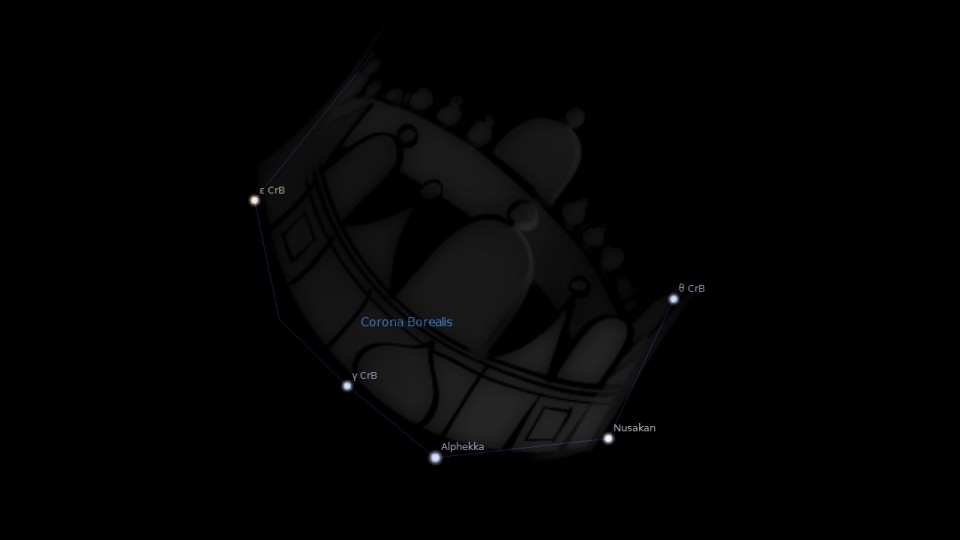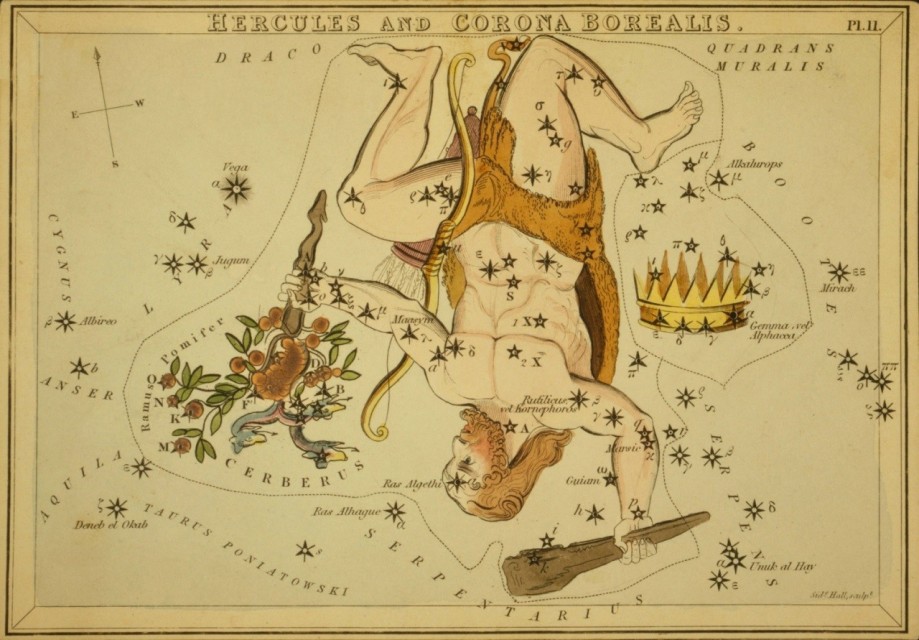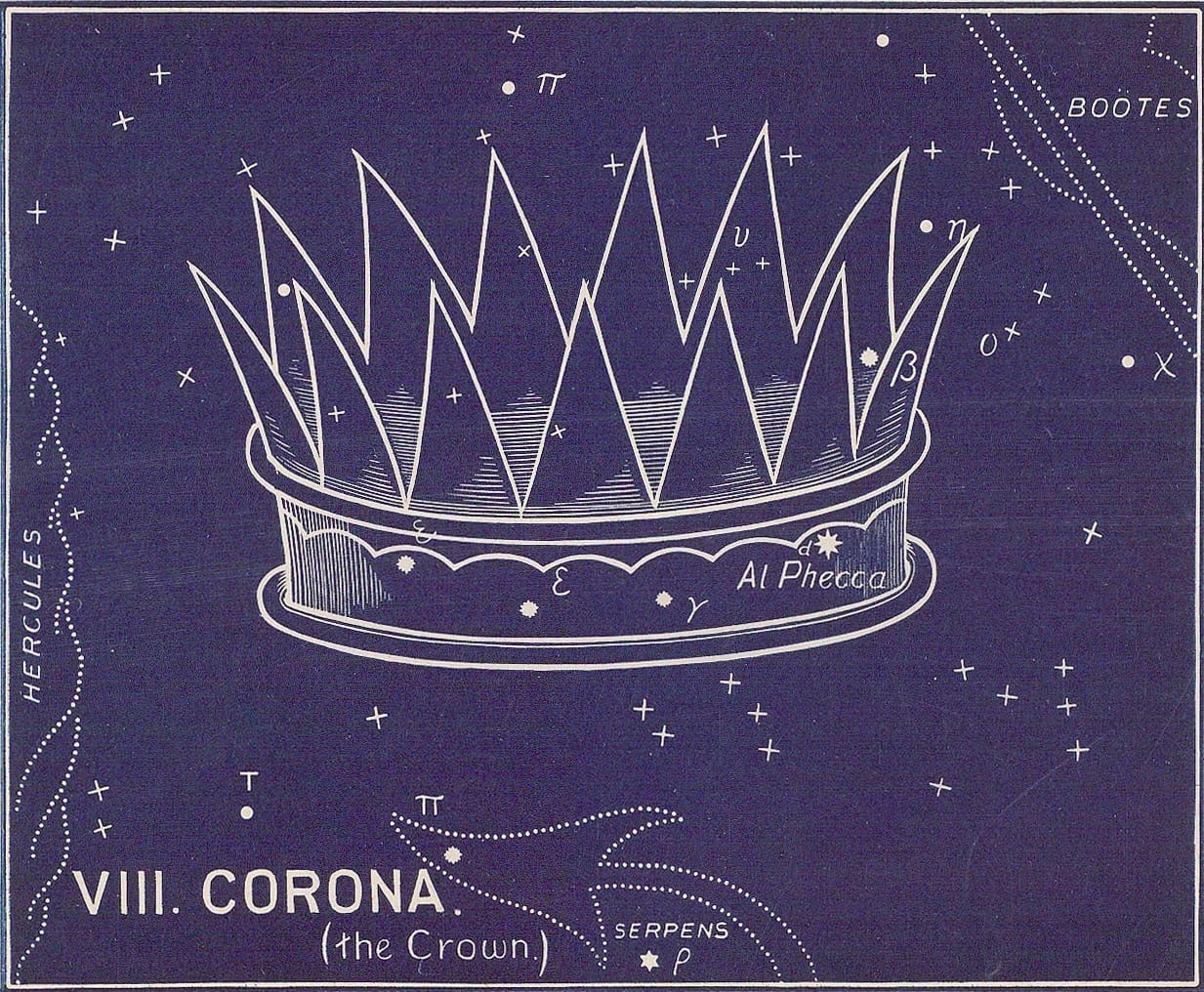FIXED STARS: Major Stars | 1000+ Stars | Constellations | About
Constellation Corona Borealis, the Northern Crown, is a northern constellation bordering Serpens, Boötes and Hercules. It is one of the 48 constellations listed by Ptolemy in the 2nd century and remains one of the 88 modern constellations. Corona Borealis spans 25 degrees of the zodiac in the Sign of Scorpio.Corona Borealis Constellation Stars
| 2000 | 2050 | Star | Name | Sp. Class | Mag. | Orb |
|---|---|---|---|---|---|---|
| 08♏16 | 08♏59 | ζ CrB | B7 | 4.64 | 1°00′ | |
| 09♏07 | 09♏49 | β CrB | Nusakan | F0 | 3.66 | 1°40′ |
| 09♏27 | 10♏09 | θ CrB | B6 | 4.14 | 1°20′ | |
| 12♏18 | 13♏00 | α CrB | Alphecca | A0 | 2.22 | 2°10′ |
| 14♏52 | 15♏34 | γ CrB | A1 | 3.81 | 1°30′ | |
| 17♏01 | 17♏44 | δ CrB | G5 | 4.59 | 1°10′ | |
| 18♏01 | 18♏43 | τ CrB | K0 | 4.73 | 1°00′ | |
| 19♏07 | 19♏49 | ε CrB | K3 | 4.14 | 1°20′ | |
| 20♏06 | 20♏48 | T CrB | Blaze Star | M3 | 10.6 | 1°00′ |
| 25♏14 | 25♏56 | ξ CrB | K0 | 4.86 | 1°00′ |
Corona Borealis Astrology
Manilius
Corona the Crown’s lustrous ring, which twinkles with varying luminosity; for the circle is dominated by a single star, which with passing splendor sparkles in the mid-forehead and enhances with its blazing flame the bright lights of the constellation. They shine as the memorial of deserted Ariadne.
Next to rise is Erigone. When you behold her ascending with five degrees wrested from the sea, there will emerge from the waves the bright memorial of what was once Ariadne’s crown: and gentle will be the skills here from bestowed. For here shines a maiden’s gifts. The child of the Crown will cultivate a garden budding with bright flowers and slopes. Grey with olive or green with grass. He will plant pale violets, purple hyacinths, lilies, poppies which vie with bright Tyrian dyes, and the rose which blooms with the redness of blood, and will stipple meadows with designs of natural color. Or he will entwine different flowers and arrange them in garlands; he will wreathe the constellation under which he was born, and like Ariadne’s crown will be the crowns he fashions; and stems he will squeeze together, and distill mixtures therefrom, and will flavor Arabian with Syrian scents and produce unguents which give off a mingled fragrance, that the charm of the perfume be enhanced by the blending. His heart is set upon elegance, fashion, and the art of adornment, upon gracious living and the pleasure of the hour. Such is the endowment prescribed by the years of the Maid and the flowers of the Crown. [1]
Robson
Legend. Corona Borealis represents the garland given by Venus to Ariadne on the occasion of her marriage to Bacchus after she had been forsaken by Theseus.
Influence. According to Ptolemy it is like Venus and Mercury. It is said to give artistic ability, love of flowers, lassitude and disillusionment, but to bring its natives to a position of command. By the Kabalists it is associated with the Hebrew letter Daleth and the 4th Tarot Trump, “The Emperor”. [2]
Noonan
The constellation is correlative with that which concerns the air and especially the weather and its effects on agriculture. It is generally a beneficial constellation. When in mutatine subsolar aspect the native will be fond of pleasure. When in matutine culmination, however, the native may prefer pleasure to the honors of life. If matutine setting, the constellation presages a propensity for pleasure that may even bring about disease, dishonor and imprisonment. [3]
Allen
Corona Borealis, the Northern Crown … was the only stellar crown known to Eratosthenes and the early Greeks, but they called it Stephanos, a Wreath; and their successors, who had begun to locate the Southern Crown (Corona Australis), added to this title of the original the distinguishing protos; and beta Borelos to show its priority and its northern position. The Latins adopted the Greek name and adjectives in Corona borea, borealis, and septentrionalis; and further knew it as the Crown of Vulcan fashioned ex auro et indicis gemmis; or of Amphitrite, probably from its proximity in the sky to the Dolphin (Delphinus) associated with that goddess.
But generally it was Ariadnaea Corona, Corona Ariadnae, Corona Ariadnes, Cressa Corona, Corona Gnosida, Corona Cretica and Gnossis, varied by Minoia Corona and Minoia Virgo found with Valerius Flaccus and Germanicus, and Ariadnaea Sidus with Ovid; these classical designations referring to Ariadne, or to her father Minos, king of Crete, and to her birthplace in that island, at Gnosos, where Theseus married her. When deserted by him she became the wife of Liber Bacchus, and so took his name Libera; while the crown that Theseus — or, as some said, the goddess Venus — had given her was transferred to the sky, where it became our Corona. [4]
Bullinger
Thou shalt also be a crown of glory in the hand of the LORD, and a royal diadem in the hand of thy God. [Isaiah 62:3]
So here, the CROSS is closely followed by the CROWN! True, “we see not yet all things put under Him, but we see Jesus… for the suffering of death crowned with glory and honor” (Heb 2:9)… The Hebrew name for the constellation is Atarah, a royal crown, and its stars are known today in the East by the plural, Ataroth! Its Arabic name is Al Iclil, an ornament, or jewel.
It has 21 stars: one of the 2nd magnitude and six of the 4th. It is easily known by the stars θ, β, α, γ, δ and ε, which form a crescent. Its brightest star, α, has the Arabic name of Al Phecca, the shining. [5]
References
- Astronomica, Manilius, 1st century AD, book 5, p.29, 321.
- Fixed Stars and Constellations in Astrology, Vivian E. Robson, 1923, p.40.
- Fixed Stars and Judicial Astrology, George Noonan, 1990, p.10.
- Star Names: Their Lore and Meaning, Richard H. Allen, 1889, p.173-175.
- The Witness of the Stars, E. W. Bullinger, 1893, Corona (the Crown).


